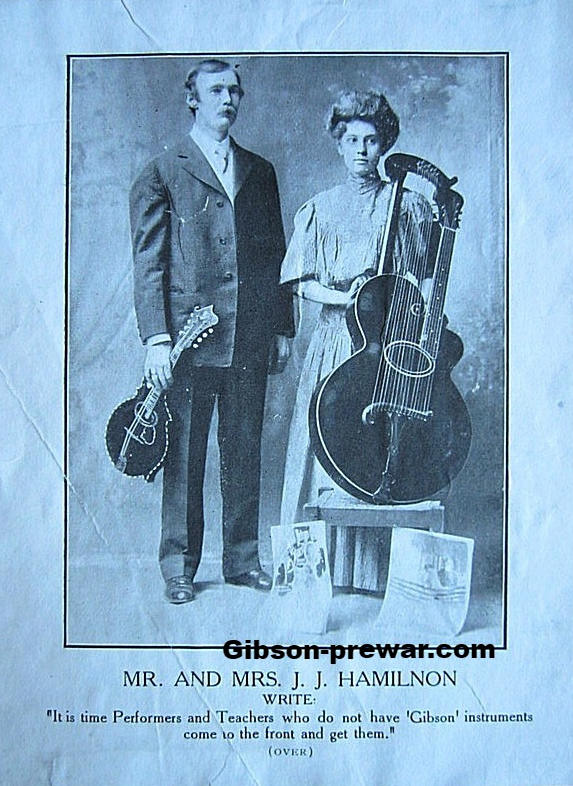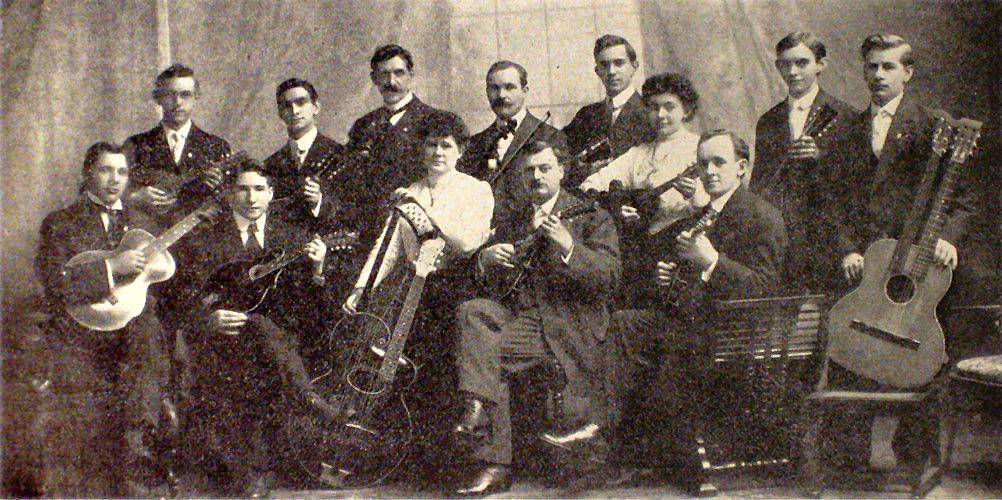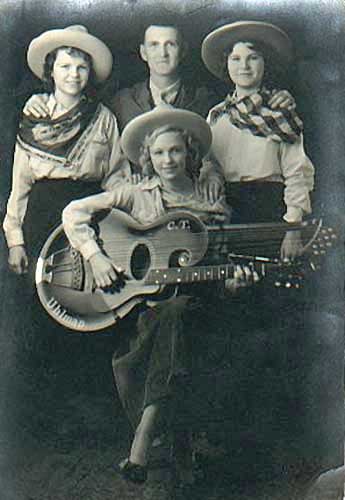Harp Guitarists in Women’s History Month continues from last episode’s hollow arm harp guitar players to the world’s most famous and historically popular harp guitar of all time: The Gibson! And, if anything, the proportion of female players of these instruments was even higher – despite the instruments being dramatically larger.
Much has already been written about the Gibson success story, a large part of which was the company’s “Teacher-Dealer” program, a sort of perpetual motion pyramid scheme that, while almost diabolically clever, gave joy and music to tens of thousands of musicians in America and even throughout the world.
Their customers ran the gamut from prestigious professionals to any beginner who could scrape up the cash to purchase one. In seemingly every town across the country, a local “BMG” music teacher familiar with banjos, mandolins and guitars, would volunteer to put together a mandolin and guitar club and earn money by both teaching his new students and selling them new Gibson instruments to play in his new community ensemble. Everybody wins!
Thus, you’ll see that the majority of these groups were all-Gibson groups. Their slogan? “Everyone a Gibson-ite!”
Month after month, readers of the BMG mags The Cadenza and The Crescendo would drool over new images of the latest Gibson clubs with their brand new shiny black exotic “Florentine” mandolins and harp guitars. (To themselves) “I would kill my own grandmother to get that harp guitar!” And so, our own great-grandmothers and grandfathers would pawn the car or some jewelry and put down their deposit.

Gibson’s 3rd Cadenza advertisement in the March 1903 issue featured their ornate Style U harp guitar.
Some perspective: In 1906, the second-finest American harp guitar – the flat-top Dyer – would set you back from $27.50 to $55 for their then top-of-the-line instrument. In 1905, if you wanted the “equivalent” 6-bass Gibson model, you’d have to pony up $222 – four times as much! The giant 12-bass model would lighten your wallet by $266, which went up to $296 in 1907. In today’s dollars, that’s almost $8300. (Although looking at it relatively, that was still a major bargain of what you’d pay any decent luthier for a comparable instrument today. Meaning, Gibsons may have been expensive, but you got your money’s worth.)
The following images include images from Gibson’s own catalogs, the two BMG magazines (Cadenza and Crescendo) along with another dozen original photos (or scans) from eBay and private parties. They show all of Gibson’s models, starting with the original “scroll-bridge” models (the “small” R at just under 18” wide and the ginormous 21” wide Style Us), then the standardized 18” wide Style U with its 10 sub-basses and floating bridge “trapeze” tailpiece.
I’m going to go in roughly chronological order of the instruments shown, and by date of publication when I can. We start with those iconic Masqueria Sisters!

The Gibson Company used two different images of the sisters and repeated them multiple times in their catalogs. This image first appeared in 1909 and the one below in 1914. However, the sisters are all playing early pre-1908 instruments; the harp guitar is the Style R with 6 sub-basses available and looks like the slightly later 1906 model.

Indeed, the trio debuted at the very end of 1906, so likely had their three beautiful Gibson instruments from the beginning. Their nationality remains somewhat of a mystery. The first reviewer described them as Italian, playing Italian folk songs. The following year, a “Mexican dance with castanets and tambourines” was mentioned. From 1908-on, they were “The Original Street Singers, Dancers and Instrumentalists.” One reviewer in 1911 described them as “beautiful Spanish girls.” Masqueria seems to be an extremely obscure surname, though appears to be of Spanish origin – precisely where is unknown (the girls were said to be from Chicago). November 29, 1916 is the last mention of them I’ve yet found.

This is New Zealand’s Christchurch Mandolin Orchestra, featured in the December 1910 Cadenza. The group formed in 1902 under the direction of Joseph Wright. His wife is the harp guitarist. It appears that Wright ordered Gibson instruments from very early on – check out the shiny, gorgeous Style O guitar with its fabulous neck inlay! The mandolins all appear to be very early and the Style R harp guitar is another c.1906 instrument. About half the instruments are Gibsons – after all, shipping could not have been inexpensive!

Mr. & Mrs. Wright also split off into the smaller Christchurch Banjo, Mandolin and Guitar Orchestra, as seen in Gibson’s 1910 catalog G.

Another circa 1905-1906 Style R harp guitar with Orville’s Crescent and Star headstock inlay. The mandolin family instruments are post-1908. This charming quintet remains anonymous.

Mrs. J. J. Hamilnon has a brand new early 1907 Style U which had just switched over to a standard number of ten sub-basses. (Courtesy Kevin Siggins at Gibson-prewar.com, a fantastic one-man repository).
Now we switch to the more common Style U that was introduced in 1908 with its standard ten sub-basses and “trapeze” tailpiece. The first dated images appear in 1910:

From The Cadenza, April 1910. Mr. Leslie H. Gallagher’s Chicago Mandolin Club features non-Gibson instruments, including a common design harp guitar that was built by many companies. Its player is Frank Collins. Mrs. Gallagher is listed as the piano accompanist, so is likely the unnamed woman holding the harp guitar sitting next to her husband. Did she play it as well?

The all-female Aeolian Mandolin and Guitar Orchestra from Canada who use “Gibson instruments exclusively” included two harp guitar players. This and the next two images are from the 1910 catalog.

This 43-member Boston Gibson orchestra featured four harp-guitarists, the woman playing the older, giant 21”-wide Gibson model along with two of the gentlemen. It’s also nice to see them joined by an actual harp!

From Gibson’s 1911 dealers’ magazine, The Sounding Board.

The Edgewood Mandolin Orchestra of Pittsburg included both male and female harp guitarists. This and the next image appeared in Gibson’s 1912 catalog H.

The New York Plectrum Society Orchestra similarly features a pedal harp, along with a woman harp guitarist and mandobassist.

Mr. and Mrs. J. J. Hamilton of Kansas, in Gibson’s 1914 Sounding Board.

Gibson’s 1917 catalog J. While women had often chosen the harp guitar during the last ten years, now we see a child mandobassist! I was also thrilled to discover the original Los Angeles orchestra, the “Gibson-ites.” Alas, this group did not survive. The LAMO I joined in the early 1980s (said to be L.A.’s first) was formed in 1954 from a group of New Yorkers. (I was its one and only ever harp guitarist, playing this same Gibson.)

An anonymous 1917 catalog entry.

Above, a fascinating image from Catalog K (1918/1919)

Catalog P, c.1926. As it should be: one of each sex on mandobass and harp guitar!
While the Gibson catalog and BMG magazine images are fascinating and of extreme historical importance, it’s always special to find one-off original images like this next one. When they have a story, like this one, it’s even more wonderful. Submitted by a fellow named Richard McFarland, he wrote:

“My grandfather was a member of a rather large mandolin orchestra in western Ohio sometime in the late teens to early twenties. Nearly 60 members strong, the orchestra includes many different models of mandolins (including two mandobass) as well as two harp guitars front and center. I never got to hear my grandfather play mandolin (I had no idea he ever had it) but I inherited his Gibson A-2 and have greatly enjoyed playing it over the years. Here’s all I know: My grandfather (he’s in the first row of “standers,” five to the left of the conductor who is at the right side) was born and lived on a farm near Donnelsville, Ohio, a small farming community near Springfield. This picture of him greatly resembles his high school graduation photo, which was taken in 1918. By 1923 he was married and farming land of his own and I doubt he would have had the time to participate in such an ensemble. I think this orchestra was probably based in Springfield, given its size, the photo evidently taken in a school gymnasium.”
Late ‘teens looks about right; the two women play both the pre- and post-1908 Style U models.

But did they play them? Well, yes, obviously. Did they play the sub-basses? They most certainly gave it a go; all the period articles of harp guitars included discussion of how the basses were played – no one ever suggested that they were ignored. Here are two serious female proponents of the instrument.
From 1921 to 1925 (above and the next 6 images), the BMG magazine and catalog images continued to increase. While clearly still going strong, we must also keep in mind the lag between the time photographs were taken, submitted and published. Indeed, this was the beginning of the end. While Gibson would keep the harp guitar in their catalog until 1941 – and stars like Eddie Peabody still played them – the company’s catalogs would now feature banjo and guitar players, with only a very rare harp guitarist.

The Kalamazoo Y. W. C. A. Mandolin Orchestra was the local women’s answer to Gibson employee Jas. H. Johnstone’s Y. M. C. A. Orchestra. I’m going to guess that the harp guitarist is founder Stella Lyle.

Stella’s image is repeated in this montage that includes a larger all-female Gibson orchestra, complete with harp guitar.

More small catalog vignettes: Cox’s Serenaders from Idaho above and below, Grace and May Peers from Mississippi and “May and Brown.”



While this 1925 image of the Joliet Mandolin Club still includes a harp guitar and mandobass – both played by women – note the appearance of at least six tenor-, mandolin- and guitar-banjos.
While the Gibson harp guitar’s heyday may have ended, its history never does, as new hundred-year-old images are discovered all the time. Here are those that come from eBay and private parties – undated, with unknown musicians, but fascinating mysterious women all the same! The often gorgeous photographs speak for themselves (don’t forget to click and expand!).




Female Gibson harp guitarist playing lap steel in a Hawaiian trio!!!

At the risk of sounding chauvinistic (which I undoubtedly am), there are lovely Gibson harp guitar players…
…and then there is Hair Lady:

I did a caption contest for the original post of this one. Feel free to play.
I’ll leave you with another great “Gibson Girl” for a palate cleanser:







There’s a whole new rabbit’s hole of history here, for you to jump in :-).
While they’re all really nice pictures, a couple of them stand out showing the deep shine of the lacquer; the Uhlman picture, in particular, puts the shine back.
p.s. I absolutely love Roland Neuwirth and his Extremschrammel approach to a lot of things that have nothing to do with schrammel, so a teaser like that is going to give me sleepless nights from anticipation until you publish. Dammit, Gregg!